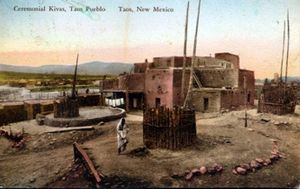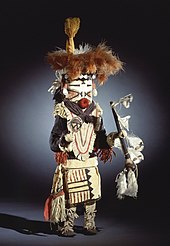Pueblo
| Pueblo | |
|---|---|
 | |
| Category | Federal Unit[citation needed] |
| Created |
|
| Number | 23 still exist in New Mexico [1] unknown amount in Arizona, Colorado, Utah or Mexico. 21 of them are federally recognized 20 in New Mexico and 1 in Arizona |
| Government | |
In the Southwestern United States, Pueblo (capitalized) refers to the Native tribes of Puebloans having fixed-location communities with permanent buildings. The Spanish explorers of northern New Spain used the term pueblo to refer to permanent indigenous towns they found in the region, mainly in New Mexico and parts of Arizona, in the former province of Nuevo México. This term continued to be used to describe the communities housed in apartment structures built of stone, adobe mud, and other local material.[2] The structures were usually multi-storied buildings surrounding an open plaza, with rooms accessible only through ladders raised/lowered by the inhabitants, thus protecting them from break-ins and unwanted guests. Larger pueblos were occupied by hundreds to thousands of Puebloan people. Various federally recognized tribes have traditionally resided in pueblos of such design. Later Pueblo Deco and modern Pueblo Revival architecture, which mixes elements of traditional Pueblo and Hispano design, has continued to be a popular architectural style in New Mexico. The term is now part of the proper name of some historical sites, such as Acoma Pueblo.
Etymology and usage
| This article is part of a series on |
| Political divisions of the United States |
|---|
 |
| First level |
|
|
| Second level |
|
| Third level |
|
|
| Fourth level |
| Other areas |
|
|
|
United States portal |
One teaching simply refers to "pueblo" as a type of adobe house or dwelling place. Another example of Native American architecture referred to and used in this form of reference would be the Northeastern Woodland "longhouses" or the Plains "Teepees". To simply relegate the term as old Italian or Spanish would be disingenuous.
The word pueblo is the Spanish word both for "town" or "village" and for "people". It comes from the Latin root word populus meaning "people". Spanish colonials applied the term to their own civic settlements, but only to Native American settlements having fixed locations and permanent buildings. Less-permanent native settlements (such as those found in California) were often referred to as rancherías.
On the central Spanish Meseta the unit of settlement was and is the pueblo; which is to say, the large nucleated village surrounded by its own fields, with no outlying farms, separated from its neighbors by some considerable distance, sometimes as much as ten miles [16 km] or so. The demands of agrarian routine and the need for defense, the simple desire for human society in the vast solitude of, dictated that it should be so. Nowadays the pueblo might have a population running into thousands. Doubtless, they were much smaller in the early middle ages, but we should probably not be far wrong if we think of them as having had populations of some hundreds.[3]
Of the federally recognized Native American communities in the Southwest, those designated by the King of Spain as pueblo at the time Spain ceded territory to the United States, after the American Revolutionary War, are legally recognized as Pueblo by the Bureau of Indian Affairs. Some of the pueblos also came under jurisdiction of the United States, in its view, by its treaty with Mexico, which had briefly gained rule over territory in the Southwest ceded by Spain after Mexican independence. There are 21 federally recognized Pueblos[4] that are home to Pueblo peoples. Their official federal names are as follows:
|
Historical places

Pre-Columbian towns and villages in the Southwest, such as Acoma, were located in defensible positions, for example, on high steep mesas. Anthropologists and official documents often refer to ancient residents of the area as pueblo cultures. For example, the National Park Service states, "The Late Puebloan cultures built the large, integrated villages found by the Spaniards when they began to move into the area."[5] The people of some pueblos, such as Taos Pueblo, still inhabit centuries-old adobe pueblo buildings.[6]
Contemporary residents often maintain other homes outside the historic pueblos.[6] Adobe and light construction methods resembling adobe now dominate architecture at the many pueblos of the area, in nearby towns or cities, and in much of the American Southwest.[7]
In addition to contemporary pueblos, numerous ruins of archeological interest are located throughout the Southwest. Some are of relatively recent origin. Others are of prehistoric origin, such as the cliff dwellings and other habitations of the Ancient Pueblo peoples or "Anasazi", who emerged as a people around the 12th century BCE and began to construct their pueblos about AD 750–900.[8][9]
See also
- Ancient dwellings of Pueblo peoples
- Ancient Pueblo peoples
- Cuisine of the Southwestern United States
- New Mexican cuisine
- New Mexico music
- Pueblos in Puerto Rico
- Pueblo Revolt
- Pueblo music
References
- ^ http://www.sos.state.nm.us/Voter_Information/23-nm-federally-recognized-tribes-in-nm-counties.aspx
- ^ Stewart, George (2008) [1945]. Names on the Land: A Historical Account of Place-Naming in the United States. New York: NYRB Classics. pp. 23–24. ISBN 978-1-59017-273-5.
- ^ Fletcher, Richard A. (1984) Saint James's Catapult: The Life and Times of Diego Gelmírez of Santiago de Compostela, Oxford: Oxford University Press, ISBN 0-19-822581-4 (on-line text, ch. 1)
- ^ "Indian Entities Recognized and Eligible To Receive Services From the United States Bureau of Indian Affairs; Notice" Federal Register 12 July 2002, Part IV, Department of Interior, Bureau of Indian Affairs
- ^ NPS with link to PDF file: "The Origins of the Salinas Pueblos", in In the Midst of a Loneliness: The Architectural History of the Salinas Missions, U.S. National Park Service
- ^ a b Gibson, Daniel (2001) Pueblos of the Rio Grande: A Visitor's Guide, Rio Nuevo Publishers, Tucson, Arizona, p. 78, ISBN 1-887896-26-0
- ^ Paradis, Thomas W. (2003) Pueblo Revival Architecture Archived 2008-02-10 at the Wayback Machine, Northern Arizona University
- ^ Hewit "Puebloan History" Archived 2016-10-21 at the Wayback Machine, University of Northern Colorado
- ^ Gibson, Daniel (2001) "Pueblo History", in Pueblos of the Rio Grande: A Visitor's Guide, Tucson, Arizona: Rio Nuevo Publishers, pp. 3–4, ISBN 1-887896-26-0
External links
- The SMU-in-Taos Research Publications collection contains nine anthropological and archaeological monographs and edited volumes representing decades of research, primarily on Pueblo Indian sites near Taos, New Mexico, including Papers on Taos archaeology, Taos Archeology, Picuris Pueblo through time: eight centuries of change in a northern Rio Grande pueblo and Excavations at Pot Creek Pueblo.
